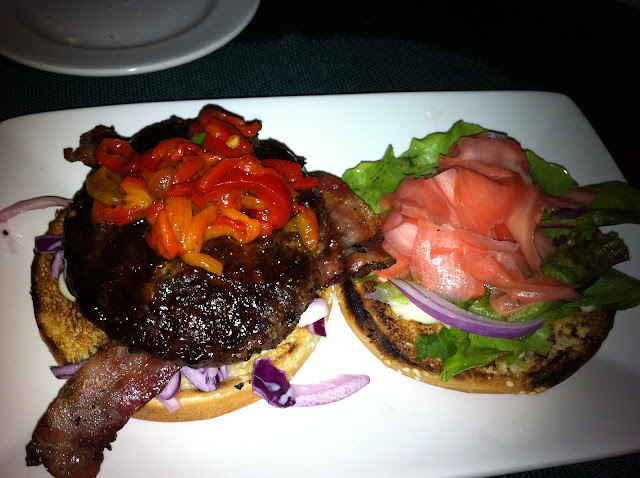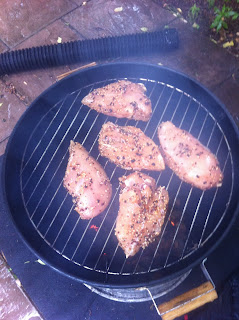Unfortunately, we had not yet returned to our native red-soiled land while this was happening and missed our chance to weigh in on the entries and cast a vote. However, fortunately some restaurants are still serving their creations, I assume mostly due to popular demand for these amazing feats of meat.
I now present to you four of the burgers that I've been able to try so far. I believe there are still more out there (I'm lookin' at you Dubfibrillator) so hopefully there will be a part two to this post...
#1 - The "East West Burger" - The Merchantman Pub
This was one of the co-winners and I certainly concur. Basically a burger with sushi condiments. Teriyaki glazed, with smoky bacon and pickled ginger as the featured toppings. It was also massive. I've had it twice already and will definitely be back again.
 |
| East meets West meets a party in my mouth |
#2 - The Lord of Montague - Sir Isaac's in Montague
The other co-winner. A pretty standard burger topped with a block of cheese, other standard toppings and banana peppers. I can see why it was received so highly because it's an excellent example of a "regular" burger, meaning that there weren't any crazy sauces, spices or toppings used besides the banana peppers... though I'm sure many asked that those be left off. It was designed to be enjoyed by the masses (even the ketchup-only burger lovers) but I'm a little more adventurous and find the other entries much more exciting/appealing.
 |
| All hail the Lord of Montague |
#3 - The Real Matterhorn - The Pilot House
Topped with swiss cheese and a pile of mushrooms, this was a top-notch burger... And I have to say to most amazing part was the crisp pretzel-like bun. I think what I had may be a slightly smaller/toned-down version of what they were serving in the Spring, but none-the-less, it was an excellent burger.
 |
| I would climb the Matterhorn... to eat the Real Matterhorn |
#4 - Three Pigs Burger - Daniel Brenan Brickhouse
Now this was a real treat. A ground pork patty topped with stringy pulled pork pork and a slice of smoked pork belly (aka Über bacon). Hmm... no beef... Well this rogue entry (if it even was an entry?) has nothing to be ashamed of. Even if it got no PEI Burger Love, it gets mine... over and over again... but I digress. Go try it for yourself and you'll understand.
 | ||
| Little pigs, little pigs, get in ma belly |
All-in-all, I've been impressed so far and look forward to future burger adventures. And who knows, maybe the Iron Donkey slider platter will step into the ring some day against these champions?
A few more pics here.
















































